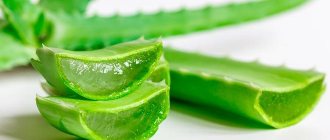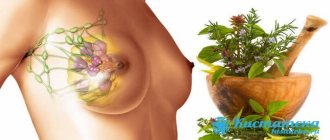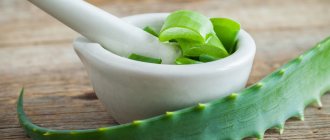How does agave affect the functioning of the gastrointestinal tract?
Neutralization of constipation
Aloe (also called agave) belongs to the group of succulents. This means that the plant actively accumulates moisture in the thickness of the fleshy leaves. It is these leaves, containing a large number of biologically active substances, that are used as the main medicinal raw material.
The substances contained in the leaves of the plant can be divided into two large groups:
- gel;
- milky juice that is found under the skin.
It is the milky juice that acts as a source of laxative components:
- the juice contains a large amount of anathraquinones (barbaloin and analogues);
- when ingested into the gastrointestinal tract, anatrquinones are converted into aloe-emodin and other substances that have a laxative effect;
- substances contained in juice stimulate peristalsis;
- The liquid found in the leaves also contains anti-inflammatory components.
The healing properties of aloe are widely known to a large number of people
. Thus, agave juice for constipation has a complex effect:
- Stopping the inflammatory process normalizes the functioning of the gastrointestinal tract as a whole.
- Feces become softer and more flexible.
- Stimulating intestinal motor function ensures quick and painless bowel movements.
Side effects and contraindications
Despite the positive effect on the body in case of digestive problems, treatment of constipation with agave must be carried out with extreme caution.
This is due to the fact that the juice contains quite active components that can lead to unwanted side effects:
- digestive disorders (nausea, vomiting);
- abdominal pain;
- colic;
- bloating.
There are contraindications to the use of aloe-based preparations:
- stomach ulcer;
- duodenal ulcer;
- acute gastritis;
- severe renal failure;
- acute cardiovascular diseases;
- allergic reactions and individual intolerance.
Aloe juice is also used for constipation, as it has a certain laxative effect.
The use of aloe for constipation in children and pregnant women
The contraindications described in the previous section concerned the use of drugs based on this plant by adults.
For children and women expecting the birth of a child, other restrictions apply:
- In its pure form, agave juice for constipation can be given to children only from 10 years of age, and then only under the supervision of the attending physician. To treat children under 10 years of age, it is advisable to use other drugs or give aloe juice mixed with apple and beetroot (1 tablespoon of plant juice per glass of 1:1 juice mixture).
- Pregnant women and women during breastfeeding are not recommended to use aloe preparations for constipation. In the first case, a violation of the tone of the uterus may occur, in the second, the components of the juice along with breast milk can enter the child’s body.
- You should also refrain from drinking aloe juice (in any form) during menstruation. Violation of this recommendation often leads to increased pain in menstruation and an increase in the volume of bleeding.
Aloe juice for constipation
The effect of aloe juice can have different directions. Aloe is used to improve the functioning of the gastrointestinal tract, speeds up digestion, helps cleanse the intestines of stagnation, makes excrement soft and accelerates their removal from the stomach.
Juice for treating constipation is extracted from the leaves of the plant by placing them in the refrigerator for a couple of weeks. In this case, biological stimulation of the beneficial properties of the drug occurs. After this, the juice is squeezed out and taken three times a day, two teaspoons for ten days. If a visible effect is observed, the dosage of use can be gradually reduced.
Taking aloe juice in the treatment of constipation helps stimulate the flow of all vital processes of the body. This leads to a ban on the use of the plant in the treatment of cancer, as well as uterine bleeding. Pregnant women should also not take it.
How to take aloe juice for constipation
Traditional medicine recommends this recipe for preparing aloe juice as a laxative in the treatment of constipation. 150 grams of the plant are crushed and poured with 300 grams of boiling water, after which it is necessary to infuse the composition for a day. After this, the composition is heated and filtered. It should be taken in equal doses up to 10 grams, three times a day, an hour before meals. The use of aloe juice in small doses can stimulate appetite and improve digestion.
Treatment of constipation using agave
You can prepare aloe for constipation yourself. To do this, just follow the simple recipes given below.
The simplest and most accessible is the juice of the plant.
Aloe juice
Most often, aloe vera for constipation is consumed in the form of freshly squeezed juice:
- Before preparing the medicine, it is advisable not to water the plant for about 2 weeks - this way the concentration of biologically active substances in the leaves will be higher.
- To prepare the composition, cut off 2-3 fleshy leaves and put them in the refrigerator (for 7-10 days). In the cold, the beneficial qualities of the plant are enhanced.
- After aging in the refrigerator, squeeze out the juice and strain through cheesecloth.
- To normalize digestion, you need to drink a teaspoon of freshly squeezed juice three times a day. It is best to do this after eating.
Recipe with honey
Another way to use aloe for constipation is a recipe with honey:
- We prepare the leaves as in the previous case - we keep them without watering and “stimulate” them in the refrigerator;
- Squeeze up to 200 ml of juice from the chilled leaves;
- take 300 ml of liquid honey and mix it with aloe juice. Store the mixture in the refrigerator in a sealed container;
- It is better to consume the honey composition twice a day on an empty stomach. The optimal dosage for an adult is a tablespoon at a time.
Aloe juice has the ability to make a solid food bolus more plastic, which allows it to leave the body more easily
Decoction of leaves
If problems with bowel movements are systematic, you can also take a decoction of the leaves of the plant:
- Cut off 4-5 large leaves and cool.
- Place the leaves in a saucepan and pour boiling water (up to 2 liters).
- Boil over low heat for 20 minutes, then leave for at least 3 hours.
You can drink aloe decoction at night for constipation - then bowel movements should occur almost immediately after waking up. But to normalize digestion in general, it is advisable to consume the decoction 3 times a day after meals, 100 ml.
Using aloe for constipation
High-quality and rapid normalization of the patient's stool is facilitated by taking a decoction based on the collection of aloe. Its use is traditional in folk medicine as a laxative.
You should definitely take a drinking decoction of aloe after meals. In this case, the dosage should be increased until the functioning of the intestines is normalized.
If constipation has reached the chronic stage, the patient should be provided with a healing mixture from the arsenal of traditional medicine, which includes aloe and honey.
Preparing the mixture involves infusing it for three hours. Take the mixture three times a day, one teaspoon. If it is necessary to ensure long-term storage of the medicine, it must be preserved using alcohol. To achieve a lasting treatment effect, aloe should be used every day without breaks. You can use aloe throughout the year.
Medicines that can be purchased in pharmacies
Aloe-based preparations can also be purchased in pharmacies. We will describe their main varieties below.
Aloe extract capsules
One of the most popular dosage forms is capsules. As a rule, in addition to the aloe extract itself, they contain vitamin E and polysaccharides (fructose).
Almost any product made from aloe has a pronounced laxative property.
Take 2 capsules twice a day. Regular use according to the doctor’s recommendations not only normalizes digestion, eliminating constipation, but also provides a general strengthening and healing effect.
Alcohol infusions
The alcohol infusion contains:
- aloe juice (freshly squeezed, concentrated);
- ethanol
The use of ethanol as the main component ensures the preservation of plant materials and also allows for an antiseptic effect.
You need to take the infusion 2 teaspoons (per glass of water) twice a day: morning and evening.
Gel
The main component of aloe gel is the contents of the fleshy part of the leaf. This dosage form is used to normalize the digestion process and solve problems with bowel movements.
The gel should be taken once a day. The volume of the drug depends on the content of active components in it.
Note! The dosage of pharmaceutical drugs may differ, so before starting the course of treatment, carefully read the instructions.
Medicinal properties of aloe
Aloe in ancient times was widely used to prepare complex balms, ointments, essences and elixirs. The pulp of the leaves of the plant has been used to heal wounds for quite a long time. Aloe juice is used to treat severe constipation as a laxative. The prepared juice of the plant is used in the manufacture of drugs for the treatment of gastritis, which occurs against the background of a general decrease in the level of acidity of gastric juice, as well as all types of chronic colitis. A syrup is made from aloe juice, which is widely used in the treatment of anemia. Also, preparations are prepared from aloe juice that eliminate damage to the skin by X-rays and can eliminate the effects of sunburn and certain skin diseases.
Aloe contraindications for constipation
Aloe for constipation is not recommended for use in the following cases:
- Serious diseases of the digestive system, for example, stomach ulcers.
- Pain in various parts of the abdomen.
- Unexplained internal bleeding.
- If bloody discharge appears in the stool.
- It is not recommended to take it simultaneously with medications, as serious adverse reactions are possible.
- Long-term use may adversely affect health.
- During pregnancy and breastfeeding, you should definitely consult your doctor.
- Children under 10 years old.
- Serious kidney and heart diseases.
- Allergic reaction to aloe extract.
The healing effect of aloe
Aloe vera has been used by people for problematic bowel movements for decades. It is used both for chronic types of constipation and for acute problems with bowel movements. This plant has an interesting composition, thanks to which it not only cleanses the intestines, but restores its damaged mucous membrane and tones the walls stretched from accumulated feces.
Aloe for constipation has mostly good reviews. Products made from the juice of this plant allow you to get rid of fecal stasis within a day. However, they are not addictive and are completely eliminated from the body along with feces.
Constipation medications based on aloe juice act on the intestines and peristalsis due to the following components:
The first substance is responsible for the accumulation of fluid in the intestines. If there is sufficient moisture, the accumulated excrement will soften. Chloride not only ensures easy passage of stool, but also prevents anal ruptures, which often accompany constipation. Therefore, aloe products are often prescribed for constipation due to hemorrhoids.
Treatment of constipation with aloe occurs quickly and effectively due to the activation of the intestinal walls with components such as glycosides and anthraquines. It is they that irritate smooth muscles, thereby ensuring good motor skills.
Recipes based on juice and leaves
To treat constipation, take aloe juice orally.
The plant must grow for at least 3 years. Aloe juice is squeezed from the leaves, and it does not need to be processed in any way; it is taken raw. Otherwise, the healing properties will disappear.
- Usually take 1 tsp. juice with water before meals, three times a day. The course of treatment should be a maximum of three days.
- Take prepared aloe juice twice a day. Constipation will stop bothering you in a few days.
- Aloe juice has a sharp, specific taste. You can use it without diluting it with anything. If it’s hard to drink like this, then mix it with 250 ml of another juice.
- You can mix it with honey and other products. Below are some recipes for preparing such a product.
How to make and take with honey?
- Half a glass of finely crushed aloe leaves is mixed with 300 g of honey.
- After this, the resulting product is infused for about a day.
- Then the infusion is kept in a water bath for about 5 minutes.
The product is taken in the morning, before meals, 1 tsp. every day. The duration of such treatment is about two months.
From the video you will learn how to prepare a laxative from aloe and honey:
With dried fruits
A good and tasty remedy for constipation is the following mixture:
- figs;
- prunes;
- dried apricot, with the addition of 50 g of honey and 50 g of aloe.
- All fruits are crushed using a meat grinder or blender.
- Then add honey and aloe to the resulting mixture.
1 tbsp. This mixture is consumed before meals in the morning. In addition, you can use the product as jam, spreading it on white bread, but after this it is advisable to drink a glass of water.
Aloe recipes for constipation
Aloe is not only a beautiful houseplant, but also a medicinal product that is widely used in medicine to treat various diseases. The juice and leaves of the plant have a positive effect on the digestive process, accelerate the absorption of beneficial microelements from food, and eliminate congestion in the intestines. You can buy ready-made preparations based on aloe extract or prepare an effective remedy for restoring normal stools at home. Next, we will look in more detail at how to effectively take aloe for constipation in adults and children.
Contraindications for aloe juice for constipation
Aloe is popularly used actively not only to treat constipation, but also to eliminate other gastrointestinal dysfunctions. However, such therapy has many contraindications:
- pregnancy and breastfeeding;
- menstruation period;
- uterine bleeding;
- hypertension;
- kidney diseases;
- pathologies of the cardiovascular system.
Aloe juice for constipation is not recommended for children under 10 years of age. Also, the gel of this plant is prohibited from taking in case of individual intolerance, manifested by an allergic reaction. Ignoring contraindications leads to the development of serious complications that do not arise when it is impossible to empty oneself.
Source
Recipes
Only a doctor can choose an effective aloe-based recipe for constipation, taking into account the health status of a particular patient.
Below we offer several safe and effective folk recipes for constipation based on aloe:
- Aloe with honey. To prepare a medicine for constipation, you need to not water the plant for two weeks. Then cut off the large and juicy leaves and put them in the refrigerator. 200 ml of fresh aloe juice should be mixed with 300 ml of natural honey. Take one large spoon before breakfast and lunch for a week. If there is no therapeutic effect, you should stop treatment and consult a doctor.
- Decoction of aloe leaves. In addition to the juice, the leaves can be used to treat constipation. To do this, you need to choose the largest and juiciest leaves. Pour a liter of boiling water over them and cook in a water bath for several minutes. Let it sit for two hours and strain. Adults can take half a glass before meals three times a day. The duration of treatment should not exceed two weeks.
Source











